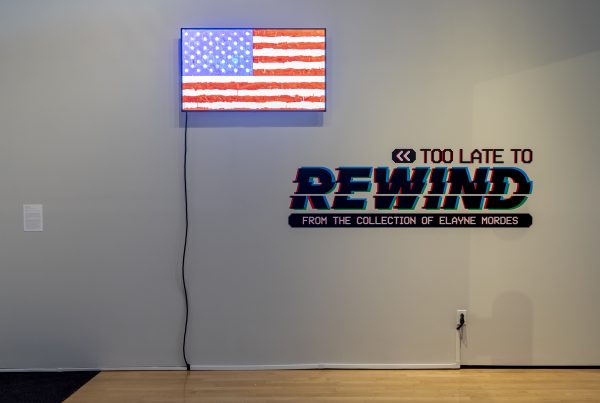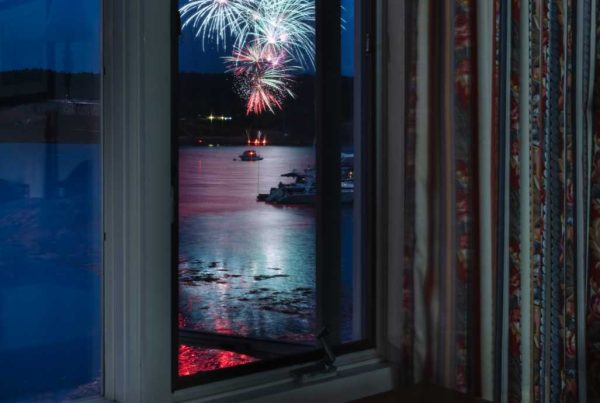The current All Florida exhibition is one of the least overtly political group shows of its kind at the Boca Raton Museum of Art, at least in recent years. Because it tends to be surrounded by pretty images of nature, Byron Keith Byrd’s provocative, abrasive “Bible Belt” is one of the exhibit’s most attention-grabbing pieces. Of course, the fact that a significant portion of his medium is an actual belt, scarred and slung vertically on a raw, wood plank dripping with paint, goes far enough on its own to distinguish itself.
For me, the dripping paint resembles blood, maybe as a result of abuse suffered at the hands of the belt – meted down by a strict religious father delivering a domestic brand of Old Testament justice. Byrd, an abstract expressionist who divides his time between Miami Beach and New York, is not a fan of organized religions, and “Bible Belt” is a preview of an upcoming series of faith-themed works to open in Miami in January.
Perhaps ironically, Byrd is a supporter of Christmas trees, at least aesthetically. In the early ’90s, he completed a photographic book about the holiday firs, and the resulting tome, “O Christmas Tree,” became the best-selling title for publisher Rizzoli. It features many celebrity trees, including those of Joan Rivers, Giorgio Armani and Vincent Price.
While your work is abstract, I feel that in the case of “Bible Belt,” you want us to take something from the work beyond an appreciation of form and color, into a place with a moral dimension and a backstory.
My first major solo exhibition was in 1979 on Madison Avenue, New York City, and featured surrealistic watercolors not unlike my works during my formative years of obtaining my BFA. Gradually through the years, my work has become increasingly more abstract and, at times, more challenging. There are numerous ways to paint an apple, but ultimately it must resemble an apple if we are to “recognize” it as an apple. My goal is to capture the essence of an “apple,” and provide visual stimulation for those willing to take a bite.”Bible Belt” utilizes my journey into abstraction, but as a new work completed in early 2011, it captures my disdain for organized religion as well as our vile political arena and uneasy status of our modern-day world.
What do you, and we, make of the text scrawled over this piece?
The text incorporated into “Bible Belt” varies: We have a minute collage applied from a vintage church hymnal, the wordplay of “PRAYS” and “PRAISE,”and, appropriately, the abbreviations of some 13 states which comprise the Bible Belt. While some charts/diagrams indicate northern parts of Florida to be included, I personally could not fathom living in this mentality — having been raised in rural Georgia prior to my move to Manhattan and South Beach. Therefore, I purposefully omitted Florida from the list…but only after asking myself “WWJD?”
As a part of your materials, how challenging – or freeing – is the medium of the belt?
The leather belt utilized in “Bible Belt” is actually embossed with praying hands, doves and tiny Bibles, so the wordplay becomes all too evident. On a deeper level, it may represent spiritual bondage and/or suffering, as well as restrictions placed on society as a result of religious convictions.
What is the message behind the “Biblical Proportions” show you’re working on, and is “Bible Belt” a part of it?
“Bible Belt” is a piece from my forthcoming series “Biblical Proportions,” which opens January 2012 at the Wynwood Exhibition Center in Miami,
following a solo retrospective of my abstract work in December at the Art Institute of Ft. Lauderdale. This is the first public venue for my new collection, which also includes a nine-foot Cross made of over 300 mousetraps, appropriately entitled “Religious Trap.” This collection was scheduled to open in a small Wilton Manors gallery on March 18, but after my New York agent sent out the press release and garnered headlines in New Zealand, the gallery owner/director cancelled the show. And I paid for the invitations, which were ready to be mailed! This seems to justify my point that many people become “trapped” within their own belief system, religious or otherwise. As I like to say, “don’t believe everything you think.”
Generally, do you want people to interpret a story, or even specific representational images, from your abstract pieces?
My evolution toward abstract expressionist painting has allowed for a more passionate relationship with my art. While any given work does not subscribe to a “strict”observation on my part, or the viewer, I do hope that one walks away from a canvas with a personal connection or feeling. My canvases are meant to evoke feeling(s). Countless times I have been told that while a person usually does not relate to abstract art, they are pleasantly surprised to have found a personal connection within my work. This, to me, denotes a successful abstract work.







